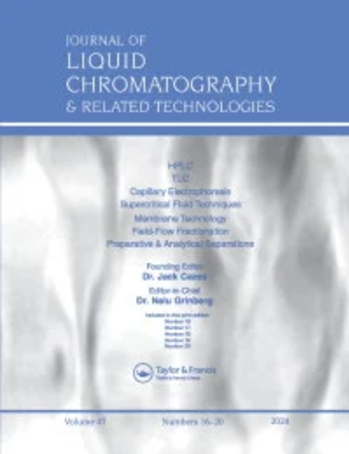Rapid screening of undeclared hypoglycemics in counterfeit herbal antidiabetic products using HPTLC-MS
IF 1.2
4区 化学
Q4 BIOCHEMICAL RESEARCH METHODS
Journal of Liquid Chromatography & Related Technologies
Pub Date : 2022-05-09
DOI:10.1080/10826076.2023.2173608
引用次数: 1
Abstract
Abstract Adulterating herbal and dietary supplements with synthetic hypoglycemics is widely practiced, especially in developing and undeveloped countries. A simple, precise, and novel method was developed to simultaneously determine synthetic antidiabetics belonging to different classes, namely biguanide, sulfonylurea, and thiazolidinedione, in counterfeit herbal products as adulterants using HPTLC-MS. The method can simultaneously identify and quantify undeclared synthetic drugs metformin, pioglitazone, glipizide, and glimepiride in herbal as well as dietary supplements. The optimized mobile phase for the TLC system consists of cyclohexane:dichloromethane:1-propanol:saturated solution of ammonium acetate in acetic acid in the ratio of (7:5:2:2, v/v/v/v). The method is highly selective and sensitive for detecting chemicals in complex herbal molecules. Identification and quantification of drugs were performed using the densitometric method. The drugs were confirmed using triple quadrupole mass spectrometry through the MS interface. The screening of market preparations revealed the presence of metformin in two of eight products. This study shows that the method for simultaneous determination of these four drugs can be applied successfully to screen synthetic antidiabetics in the herbal complex matrix as adulterants. Graphical abstract利用HPTLC-MS快速筛选假冒中药降糖药中未申报的降糖药
在草药和膳食补充剂中掺入合成降糖药是一种广泛的做法,特别是在发展中国家和不发达国家。建立了一种简便、准确、新颖的hplc - ms同时测定假药中双胍类、磺脲类和噻唑烷二酮类合成降糖药的方法。该方法可同时鉴别和定量中药及膳食补充剂中未申报的合成药物二甲双胍、吡格列酮、格列吡嗪和格列美脲。TLC系统的优化流动相为环己烷:二氯甲烷:1-丙醇:乙酸铵饱和溶液,比例为(7:5:2:2,v/v/v/v)。该方法对检测复杂草药分子中的化学物质具有高度的选择性和灵敏度。采用密度法对药物进行鉴定和定量。通过质谱界面采用三重四极杆质谱法对药物进行确证。对市场制剂的筛选显示,8种产品中有2种含有二甲双胍。本研究表明,同时测定这四种药物的方法可以成功地用于筛选草药复合基质中合成的抗糖尿病药物作为掺假物。图形抽象
本文章由计算机程序翻译,如有差异,请以英文原文为准。
求助全文
约1分钟内获得全文
求助全文
来源期刊
CiteScore
2.80
自引率
0.00%
发文量
29
审稿时长
4.9 months
期刊介绍:
The Journal of Liquid Chromatography & Related Technologies is an internationally acclaimed forum for fast publication of critical, peer reviewed manuscripts dealing with analytical, preparative and process scale liquid chromatography and all of its related technologies, including TLC, capillary electrophoresis, capillary electrochromatography, supercritical fluid chromatography and extraction, field-flow technologies, affinity, and much more. New separation methodologies are added when they are developed. Papers dealing with research and development results, as well as critical reviews of important technologies, are published in the Journal.

 求助内容:
求助内容: 应助结果提醒方式:
应助结果提醒方式:


